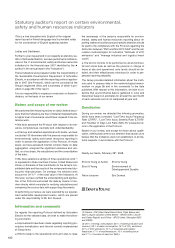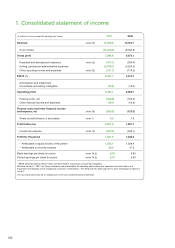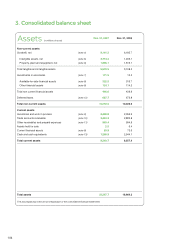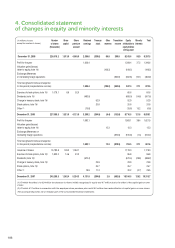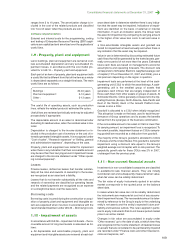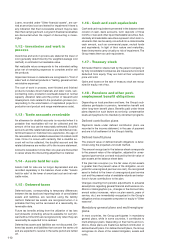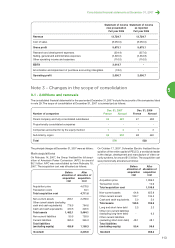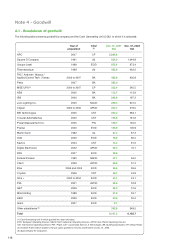APC 2007 Annual Report Download - page 111
Download and view the complete annual report
Please find page 111 of the 2007 APC annual report below. You can navigate through the pages in the report by either clicking on the pages listed below, or by using the keyword search tool below to find specific information within the annual report.
5
Consolidated financial statements at December 31, 2007
ranges from 3 to 10 years. The amortization charge is in-
cluded in the cost of the related products and classified
into “Cost of sales” when the products are sold.
Software implementation
External and internal costs for the programming, coding
and testing of Enterprise Resource Planning (ERP) appli-
cations are capitalized and amortized over the applications’
useful lives.
1.9 - Property, plant and equipment
Land, buildings, plant and equipment are carried at cost,
less accumulated depreciation and any accumulated im-
pairment losses, in accordance with the cost model pro-
vided for in IAS 16 –
Property, plant and equipment
.
Each part of an item of property, plant and equipment with
a useful life that is different from that of the item as a whole
is depreciated separately on a straight-line basis. The main
useful lives are as follows:
The useful life of operating assets, such as production
lines, reflects the related products’ estimated life cycles.
Useful lives are reviewed periodically and may be adjusted
prospectively if appropriate.
The depreciable amount of an asset is determined after
deducting its residual value, when the residual value is ma-
terial.
Depreciation is charged to the income statement or in-
cluded in the production cost of inventory or the cost of in-
ternally-generated intangible assets. It is recognized under
"Cost of sales", "Research expenses" or “Selling, general
and administrative expenses”, depending on the case.
Property, plant and equipment are tested for impairment
when there is any indication that their recoverable amount
may be less than their carrying amount. Impairment losses
are charged to the income statement under “Other operat-
ing income/(expense)”.
Leases
Finance leases, defined as leases that transfer substan-
tially all the risks and rewards of ownership to the lessee,
are recognized as an asset and a liability.
Leases that do not transfer substantially all the risks and
rewards of ownership are classified as operating leases
and the related payments are recognized as an expense
on a straight-line basis over the lease term.
Borrowing costs
Borrowing costs incurred during the construction or acqui-
sition of property, plant and equipment and intangible as-
sets are expensed when incurred, in accordance with the
recommended treatment under IAS 23 –
Borrowing Costs
.
1.10 - Impairment of assets
In accordance with IAS 36 –
Impairment of Assets
– the re-
coverable amount of long-lived assets is assessed as fol-
lows:
All depreciable and amortizable property, plant and
equipment and intangible assets are reviewed at each bal-
ance sheet date to determine whether there is any indica-
tion that the asset may be impaired. Indications of impair-
ment are identified on the basis of external or internal
information. If such an indication exists, the Group tests
the asset for impairment by comparing its carrying amount
to the higher of fair value less costs to sell and value in
use.
Non-amortizable intangible assets and goodwill are
tested for impairment at least annually and when there is
any indication that the asset may be impaired.
Value in use is determined by discounting estimated future
cash flows that will be generated by the tested assets, gen-
erally over a period of not more than five years. Estimated
future cash flows are based on management’s economic
assumptions and operating forecasts. The discount rate
corresponds to Schneider Electric’s weighted average cost
of capital (7.5% at December 31, 2007 and 2006), plus a
risk premium depending on the region in question.
Impairment tests are performed at the level of the cash-
generating unit (CGU) to which the asset belongs. A cash-
generating unit is the smallest group of assets that
generates cash inflows that are largely independent of
those cash flows from other assets or groups of assets. At
Schneider Electric, CGUs generally correspond to the Op-
erating Divisions (Europe, North America, Asia-Pacific and
Rest of the World). Each of the Growth Platform busi-
nesses is also a CGU.
Goodwill is allocated to a CGU when initially recognized.
This allocation is made on the basis used to track the per-
formance of Group operations and to assess the benefits
derived from the synergies of the business combination.
If the recoverable amount of an asset or CGU is lower than
its carrying amount, an impairment loss is recognized. To
the extent possible, impairment losses on CGUs compris-
ing goodwill are recorded as a deduction from goodwill.
The majority of the Group’s goodwill is allocated to CGUs
in Europe and the United States. This goodwill is tested for
impairment using a discount rate equal to the Group’s
weighted average cost of capital, with no risk premium. The
perpetutity growth rate for these CGUs was 2% in 2007,
unchanged from the previous year.
1.11 - Non-current financial assets
Investments in non-consolidated companies are classified
in available-for-sale financial assets. They are initially
recorded at cost and subsequently measured at fair value,
when fair value can be reliably determined.
The fair value of equity instruments quoted in an active
market corresponds to the quoted price on the balance
sheet date.
In cases where fair value can not be reliably determined,
the instruments are measured at cost net of any accumu-
lated impairment losses. The recoverable amount is deter-
mined by reference to the Group’s equity in the underlying
entity’s net assets and the entity’s expected future prof-
itability and business outlook. This rule is applied in partic-
ular to equity instruments that do not have a quoted market
price in an active market.
Changes in fair value are accumulated in equity under
"Other reserves” up to the date of sale, at which time they
are recognized in the income statement. Unrealized losses
on assets that are considered to be permanently impaired
are recorded under "Finance costs and other financial in-
come and expense, net".
Buildings : 20-40 years
Plant and equipment : 3-10 years
Other : 3-12 years
109



